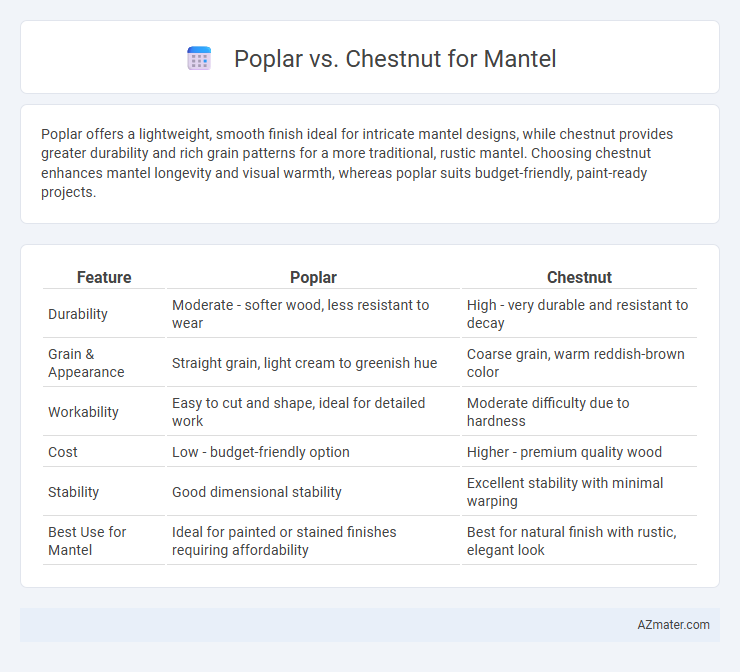Poplar offers a lightweight, smooth finish ideal for intricate mantel designs, while chestnut provides greater durability and rich grain patterns for a more traditional, rustic mantel. Choosing chestnut enhances mantel longevity and visual warmth, whereas poplar suits budget-friendly, paint-ready projects.
Table of Comparison
| Feature | Poplar | Chestnut |
|---|---|---|
| Durability | Moderate - softer wood, less resistant to wear | High - very durable and resistant to decay |
| Grain & Appearance | Straight grain, light cream to greenish hue | Coarse grain, warm reddish-brown color |
| Workability | Easy to cut and shape, ideal for detailed work | Moderate difficulty due to hardness |
| Cost | Low - budget-friendly option | Higher - premium quality wood |
| Stability | Good dimensional stability | Excellent stability with minimal warping |
| Best Use for Mantel | Ideal for painted or stained finishes requiring affordability | Best for natural finish with rustic, elegant look |
Overview: Poplar vs Chestnut Mantels
Poplar mantels offer a smooth, lightweight wood that is easy to paint and stain, making them versatile for various interior styles. Chestnut mantels provide a durable, richly grained hardwood with natural resistance to decay, ideal for a more traditional or rustic aesthetic. Both woods have distinct characteristics, with poplar being more affordable and chestnut valued for its strength and unique grain patterns, influencing mantel selection based on budget and design preference.
Wood Characteristics: Poplar and Chestnut
Poplar wood is lightweight and has a fine, even grain with a pale yellow to light green hue, making it easy to paint and stain for mantel applications. Chestnut offers a coarser grain with rich, warm tones ranging from light brown to deep reddish-brown, providing a durable and visually striking mantel surface. Both woods have moderate hardness, but chestnut's natural resistance to decay and wear makes it a preferred choice for long-lasting mantelpieces.
Durability and Strength Comparison
Poplar offers moderate durability with a Janka hardness of about 540, making it softer and less resistant to dents and scratches compared to chestnut. American chestnut, historically valued for its strength and decay resistance, has a Janka hardness of approximately 660, providing better durability and structural integrity for mantel applications. Chestnut's superior strength and resistance to wear make it a more reliable choice for long-lasting, sturdy mantels in high-traffic environments.
Appearance and Grain Patterns
Poplar offers a light, creamy hue with a relatively uniform grain pattern, making it ideal for a smooth, consistent mantel appearance. Chestnut features a rich, warm tone with prominent, varied grain patterns that add character and a rustic charm to mantel designs. The choice between poplar and chestnut depends on whether a sleek, understated look or a textured, natural finish is preferred.
Color and Finishing Options
Poplar wood offers a pale, creamy white tone with a smooth, uniform grain that readily accepts paints and stains, making it ideal for customizable mantel finishes. Chestnut features a warm, rich brown color with natural variations and prominent grain patterns, providing a rustic and classic appearance with fewer stain options to preserve its character. Poplar is favored for versatile, painted mantels, while chestnut is preferred for natural or lightly stained finishes that highlight its distinctive grain and color depth.
Cost Differences between Poplar and Chestnut
Poplar is significantly more affordable than chestnut, with prices typically ranging from $2 to $4 per board foot compared to chestnut's $8 to $12 per board foot due to its abundance and faster growth rate. The lower cost of poplar makes it a budget-friendly choice for mantel construction, especially in large or custom projects. Chestnut, prized for its rich color and durability, commands a premium price, reflecting its scarcity and historical demand in fine woodworking.
Workability and Installation
Poplar offers superior workability due to its soft texture, making it easier to cut, shape, and sand for mantel installations, ideal for intricate designs. Chestnut, while denser and harder, provides excellent durability but requires more effort and specialized tools during work and installation. Both woods offer unique benefits, but poplar's ease of handling often leads to faster and more precise mantel fitting.
Maintenance and Longevity
Chestnut mantels offer superior durability and require less frequent maintenance compared to poplar, making them ideal for long-term use in high-traffic areas. Poplar mantels, while more affordable and easier to paint or stain, are softer and more prone to dents and scratches, necessitating regular upkeep to maintain appearance. The natural hardness and resistance of chestnut ensure greater longevity, reducing the need for refinishing or repairs over time.
Eco-Friendliness and Sustainability
Poplar wood ranks high in eco-friendliness due to its rapid growth rate and abundance, making it a sustainable choice for mantel construction. Chestnut, once overharvested, has seen a resurgence through managed forestry practices that enhance its sustainability without compromising durability. Both woods offer environmentally responsible options, but poplar's faster renewability often results in a lower carbon footprint compared to chestnut.
Which Wood is Best for Your Mantel?
Poplar offers a smooth texture and light color, making it ideal for painted mantels with a budget-friendly option, while chestnut features a rich, warm tone and natural durability that enhances the mantel's aesthetic and longevity. Chestnut's resistance to decay and its attractive grain pattern make it suitable for mantels exposed to varying temperatures and humidity. Selecting the best wood depends on whether you prioritize cost and paintability (Poplar) or natural beauty and durability (Chestnut) for your mantel.

Infographic: Poplar vs Chestnut for Mantel
 azmater.com
azmater.com